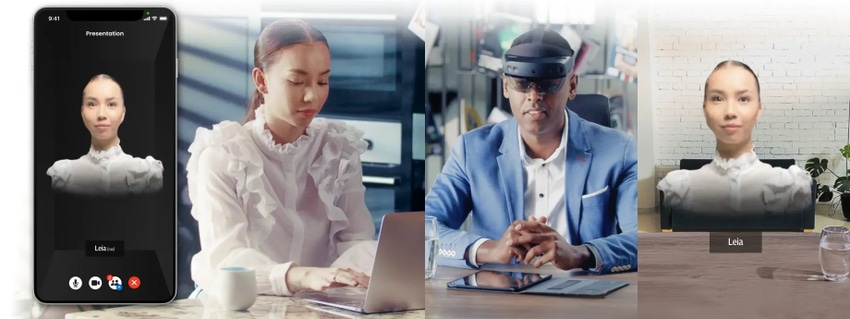A group comprising some of Europe's biggest operators has given the nascent holographic calling market a much-needed dose of credibility.
September 21, 2022

A group comprising some of Europe’s biggest operators has given the nascent holographic calling market a much-needed dose of credibility.
Deutsche Telekom, Orange, Telefónica and Vodafone have conducted a pilot with Matsuko, a Slovakia-based start-up that has developed a holographic calling app that works on smartphones, tablets, and mixed reality (MR) glasses, including Microsoft’s HoloLens 2. According to its Website, support for Meta’s Oculus Quest 2 VR headset, and Jio Glass – Reliance Jio’s MR glasses – is also in the pipeline. The pilot study could pave the way for reliable and intuitive cross-operator holographic calling.
The app works a little bit like a video call. However, instead of the call receiver seeing a flat video feed of someone sitting in their office, they are greeted by an image of the caller rendered in 3D and superimposed over the receiver’s location.
The 3D rendering takes place in the cloud, and works by taking the caller’s moving image from the front-facing camera, cropping out the background, and wrapping their visage around some polygons. It then sends the 3D rendition of the caller onto the receiver’s screen. If that screen is on a pair of MR glasses, then the caller floats, ghostlike, in front of the receiver’s eyes. If they are using a smartphone, then the app makes use of the receiver’s rear-facing camera to project the caller over whatever that camera is pointed at, like a chair in an office meeting room, for example.
In terms of communicating, there doesn’t appear to be anything that a user can achieve with Matsuko that can’t be achieved using Teams or Zoom calling – judging by the promotional video, anyway. What Matsuko does promise though is a much more immersive experience compared to a bog-standard video call.
Speaking of which, conducting a high-definition, glitch-free video call requires a fast and reliable connection. Understandably, a ‘holographic’ call, replete with real-time cloud-based 3D rendering, is considerably more demanding.
This is where operators come in.
In a joint statement, Deutsche Telekom et al explained how together with Matsuko they are leveraging their 5G networks and developing a common platform in an effort to make holographic calling be as straightforward as making a phone call. They claim that the work they have done so far has resolved network-related issues that impeded smooth and natural holographic movement, and improved the colour and resolution of holograms, increasing the degree of realism.
The group also plans to explore the potential of broadcast-like delivery, where entire presentations or events can be attended in holographic form.
“Thanks to this unique multi-operator collaboration, we are preparing our infrastructure to deliver open, interoperable and easy-to-use holographic communication services. A first but meaningful step towards the metaverse, a world in which Orange will support its customers with new experiences and interaction possibilities,” said Karine Dussert-Sarthe, EVP of marketing and design, Orange Innovation, in a statement.
“We are confident that in the near future, we will be able to offer our customers a new way of communicating, using this new holographic technology to deliver a more immersive ‘virtually there’ experience. Our cross-operator collaboration with Matsuko will help to accelerate this innovation and ensure that it works no matter which operator you choose,” added Daniel Hernández, VP of devices and consumer IoT at Telefónica.
Rest assured there were similarly-enthusiastic comments from Deutsche Telekom and Vodafone.
The pilot study with Matsuko comes at an interesting time for the extended reality (XR) market. As IDC noted in June, VR is on the up, with headset volumes expected to reach 13.9 million this year, up 26.6 percent on 2021. However, the same cannot be said of the AR market. On Tuesday, IDC said AR headset volumes are expected to decline in 2022 by 8.7 percent on last year to just 260,000 units. The research firm said volumes have slowed in recent quarters due to the shaky financials of some AR OEMs, the lack of new devices, and short-term end-user demand being fulfilled by smartphone AR apps.
“We’re still years away from mass consumer adoption of AR glasses, and the earliest time-frame for such products would be in late 2024 or early 2025 as companies such as Apple, Meta, and others use what they’ve learned from virtual reality headsets to launch a more streamlined and consumer friendly design for AR glasses,” said Jitesh Ubrani, research manager, mobility and consumer device trackers at IDC.
Matsuko, together with its new European operator partners, might just give the AR the industry a welcome shot in the arm.
Get the latest news straight to your inbox. Register for the Telecoms.com newsletter here.
About the Author(s)
You May Also Like








.png?width=300&auto=webp&quality=80&disable=upscale)


_1.jpg?width=300&auto=webp&quality=80&disable=upscale)


.png?width=800&auto=webp&quality=80&disable=upscale)